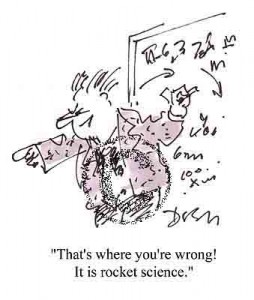It’s only April, barely the start of 2012’s vendor and industry conferences with their associated rebrandings, new positionings, exciting partnerships and product announcements, and I’m already tired of the constant drumbeat on mobile/social/big data/in-memory/analytics/consumerization etc. of enterprise HRM software. When everybody’s talking about the same things — even if most vendors don’t have many to most of these capabilities yet, let alone done very well, and most customers don’t even have good enough core data with which to generate believable metrics — I find myself thinking about what’s next. Or perhaps it’s just the realization that achieving SaaS InFullBloom will be the last generational change of my career, so I’m hoping everyone will get on with it.
I’ve been writing, speaking and consulting about great HRM software for as long as I can remember. Long before anyone would listen, I preached the power of domain models in the HRM software lifecycle (does anyone remember InPower?). While my short term memory has always been questionable, I’m very clear about the first time I used the term KSAOC and the first project I did to model the HRM domain. The foundations for SaaS InFullBloom were laid in the earliest days of my solo consulting practice. More recently, I’ve embraced mobile, social, big data, analytics, in-memory (and not just for analytics), the consumerization of enterprise IT, embedded intelligence and so much more, updating my long-held ideas about preferred architectural behaviors for an always on, always moving, highly collaborative workforce and building out my HRM object model and architectural principles accordingly.
There’s been quite a long gestation period for the adoption of modern HRM object models and the very recent adoption of models-driven development, not to mention a ton of other “preferred behaviors” for great HRM software, and that’s gotten me to wondering about what will come next? What’s going to happen that won’t take hold until long after I’ve “hung up my spurs.” But there’s a ton more to do before the best of today’s leading edge capabilities have so far permeated the enterprise as to have a positive and measurable impact on overall business results. Hell, there are still organizations that don’t deploy any flavor of self-service and are running their businesses with not much more than a payroll system when it comes to human resource management. Given the pace of HR’s adoption of the best of current HRM and the related use of technology, I can’t wait for the best of current thinking to be implemented widely enough to be considered pervasive before figuring out what’s coming next.
So what is coming next? If anyone does know, that’s certainly not me. But I do have some thoughts:
- I think we must get to universal biomedical identity management ASAP. One project in this area that I’ve been watching with great interest is India’s plan to identify all of its citizens biometrically. Don’t we all have a spreadsheet with our log-ins and passwords and secret identification questions with their answers? Yes, I know that there’s a app for that, but if you think I’m going to trust that app not to get hacked, you’re nuttier than I am.
- Models-driven development, now used prominently by Workday, provides so much benefit in time, cost and quality to market that it’s destined to become far more widely used than it is now. But there are at least two huge challenges to be addressed: (1) very few HRM subject matter experts can translate their knowledge quickly into reliable object models, into the patterns in the problem that are the essential foundation of models-driven development and (2) there are no commercially available CASE tools or PaaS that provide the required preferred behaviors for HRM software “out of the box” with only object models as their input. Sounds like whoever has built and owns such tools will have a serious leg up.
- Keyboards for fingers or just thumbs, traditional or fruity gesture touch screens, and even current voice recognition capabilities are just too slow and error-prone to keep up with today’s pace of information creation, so I’m hoping for implants and telepathy. That would solve the bandwidth constraints and costs with which we’re all living, eliminate the proliferation of devices, and take full advantage of the speed of thought. Of course that would also increase the speed of errors, but no technology is going to be perfect.
- Interrogatory configuration is something I’ve written about and worked at for years, but without much success. I still believe it’s the necessary future of HRM software, from earliest marketing interactions through the initial and then continuous implementation that is the nature of true SaaS. There are huge barriers to accomplishing this, including (1) the need for an underlying object architecture whose objects can be configured on the fly, with those configurations effective-dated, and (2) the need for an extremely robust understanding in the patterns of both regulated and good practice HRM to underpin the interrogation’s natural decision trees and state processing logic. But the potential lift here is so enormous that I sincerely hope someone will get this right.
Meanwhile, I’m still struggling to migrate to Windows Outlook from my incredibly powerful, totally custom, contacts management database, built 20+ years ago with no longer supported tools, and bitching daily about what I’m giving up to use Outlook. How could they not understand that many people have seasonal residences, that families consist of multiple individuals each of whom has their own mobile phone number, and that entries should be effective-dated. Yup, we’ve still got some work to do just to catch up with yesterday.
